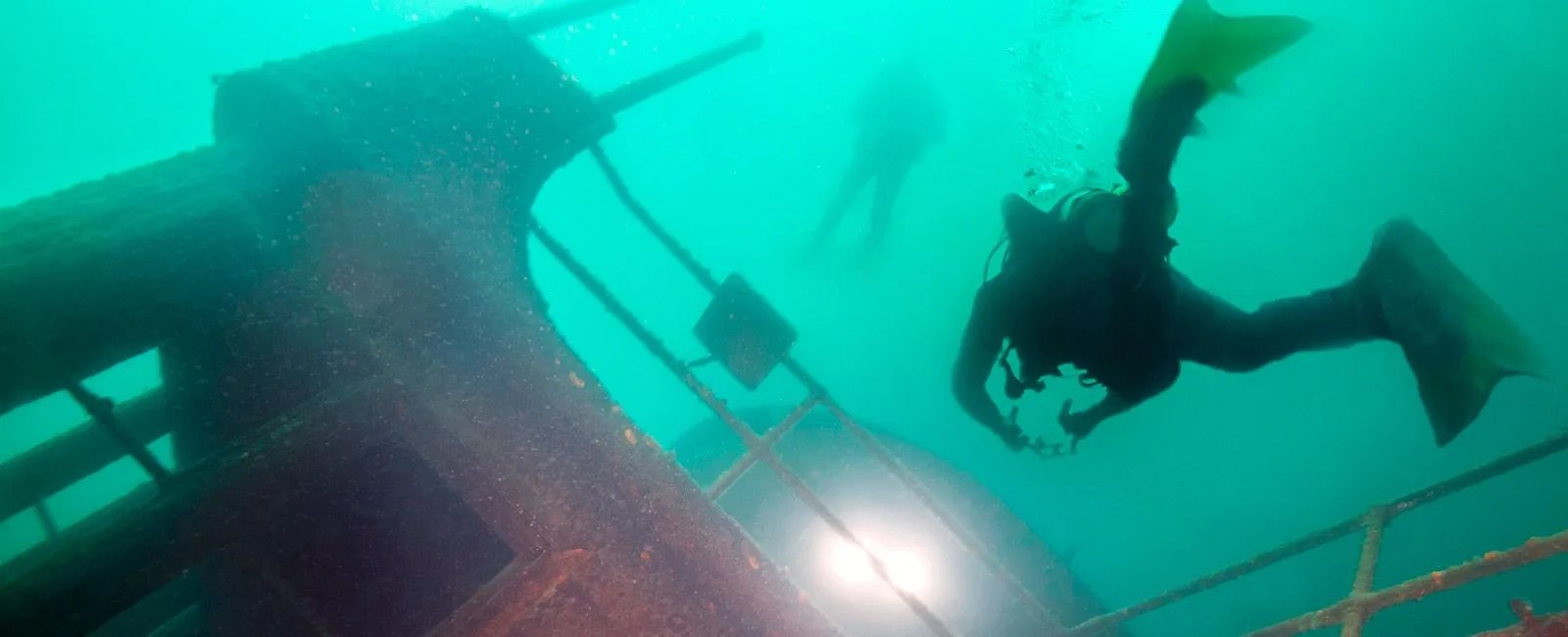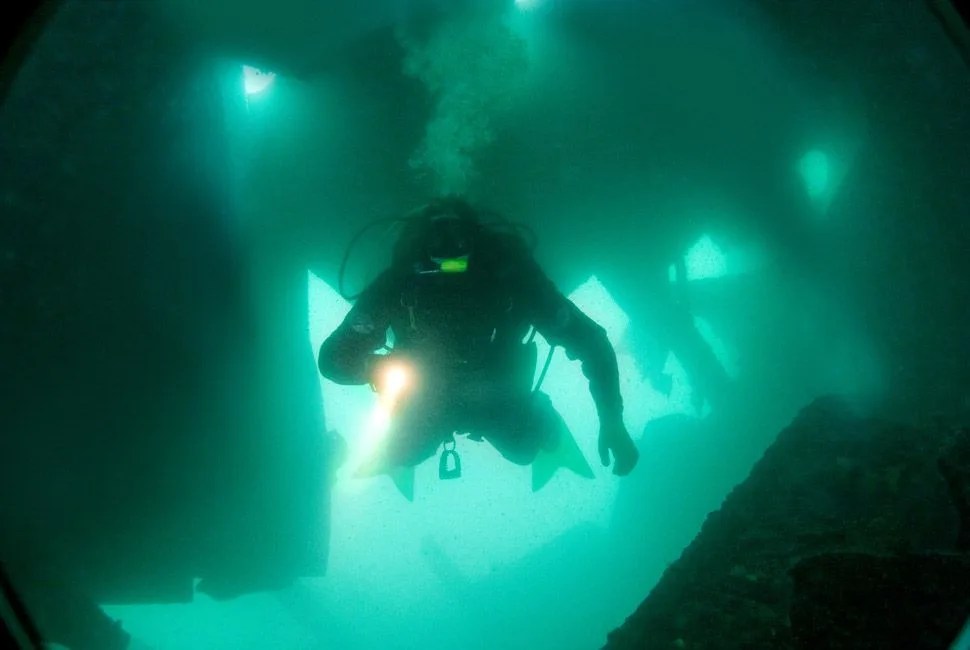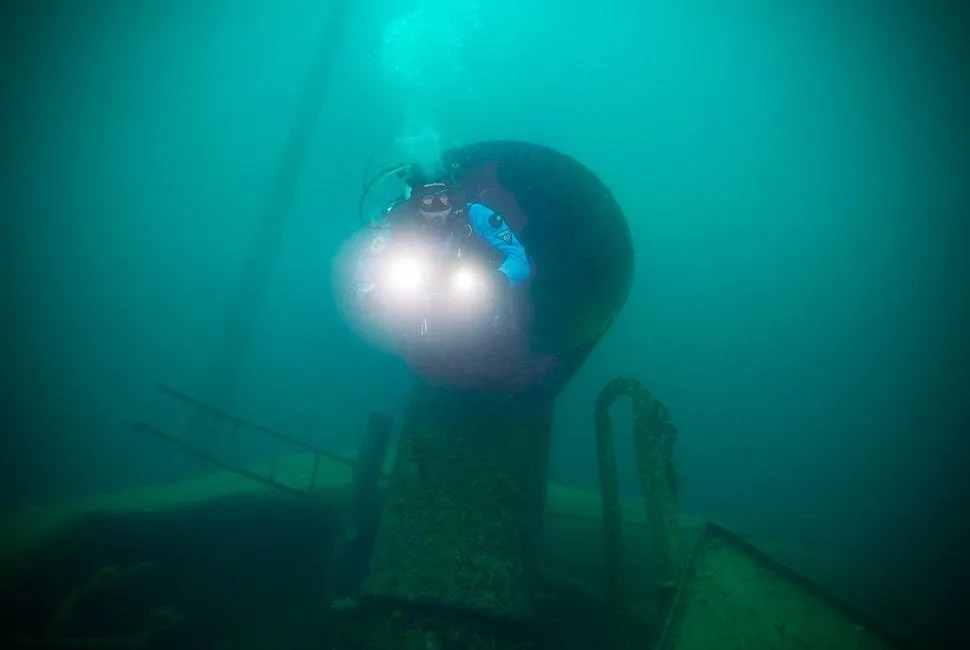
A quarter mile off the rocky beach and 75 feet underwater I’m hunting for the pilothouse. Sucked off the Madeira’s deck when she sank, it lies farther down the rubble slope, standing upright without a roof, its binnacle still in place, as if charting a course for deeper water. But I can’t find it. I’ve spent too much time exploring the winches on the twisted foredeck and my air is getting low so I ascend to the surface. The blinding sunshine feels good on my face after half an hour in 45-degree water and I float on my back for a moment before starting the long swim for shore. The pilothouse will have to wait for another year and another dive.
The Great Lakes have long been an artery from the heart of the United States to the coast. Five lakes connected by locks and rivers create a waterway from Duluth, Minnesota to the Atlantic and ships have plied these waters since the early 1800s. But with its short-frequency wave action and sometimes-brutal weather, navigating the lakes is not without risk. Big freighters run the gauntlet of wind and weather from March to December, hauling ore, cement and grains from the wheat fields and Iron Range to the blast furnaces and mills of Detroit, Gary, or further on to Europe. Most of the time the big boats do fine, sailing in the lee of the headlands, hiding in sheltered bays when the storms pass. But not always. The lakes are riddled with the remains of well over 6,000 shipwrecks which have claimed over 30,000 lives.
The 436-foot Madeira was a schooner barge that sank in November of 1905, during one of the worst storms Lake Superior has ever seen. The Mataafa Storm, as it was known, produced wind speeds as high as 70 mph and huge waves, while dumping snow and sleet on the sailors who braved it. 29 ships were lost during the two-day storm, and 36 lives lost, including the Madeira’s first mate. So costly and violent was the Mataafa Storm that it prompted the US Coast Guard to build a lighthouse on the cliff above where the Madeira sank. Today, tourists climb the stairs to the top of the lighthouse while divers brave the cold waters to visit the wreck below.
4 photos
Shipwreck diving has a macabre element to it. Wrecks are often grave sites, the result of great tragedy and symbols not only of man’s hubris and errors in judgment but also his bravery and ingenuity. They have a mysterious pull, these giant complicated structures hidden from plain sight, resting in a place they aren’t meant to be. The cold waters found in Lakes Superior, Michigan, Huron, Erie and Ontario inhibit the growth of marine organisms that consume wooden wrecks, while the lack of salt means no rust. These factors conspire to effectively preserve a three-dimensional archive of maritime history at the bottom of the lakes. Diving on a Great Lakes shipwreck is often like seeing a ship the way she looked the day she went down. For those willing to tolerate very cold water and don an astronaut’s worth of life-sustaining equipment, the Great Lakes are as good or better than almost anywhere else in the world — Truk Lagoon, Scapa Flow, anywhere.
Analog Reliability Meets State of the Art Details in the TUDOR Pelagos
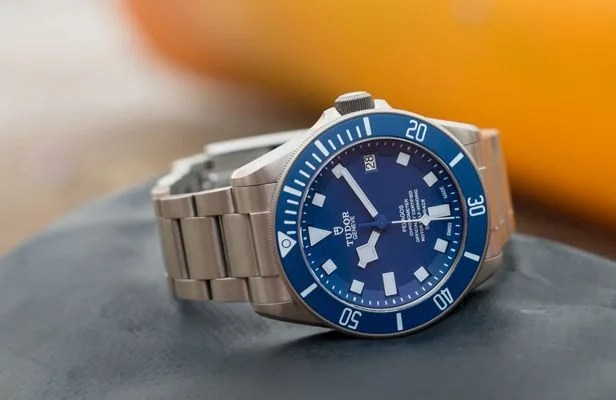
While most divers these days opt for a digital dive computer, there’s still room for a dive watch on your other wrist; analog still wins when it comes to timing swim distances, surface intervals and decompression stops. TUDOR has been building dive watches since 1954 and Pelagos is the latest in that long lineage. The “snowflake” hour hand and blue dial have historical precedence in the watches TUDOR built for the French Navy beginning in the 1960s, but a titanium and steel case and innovative spring-loaded clasp that expands over a drysuit sleeve are state of the art. Inside ticks the caliber MT5612, one of TUDOR’s first in-house movements, with a silicon hairspring unaffected by magnetism. Pelagos is rated to over 1,600 feet of water pressure — twice as deep as any wreck found in the Great Lakes.
Learn More: Here
Seven miles offshore from Milwaukee’s morning traffic gridlock, I’m 130 feet deep in Lake Michigan and 85 years in the past. In front of me is a railroad car, its wheels easily discernible but its top crushed down like a soda can. The rail car is sitting on the lake bottom, underneath the aft end of the SS Milwaukee, a 340-foot ferry that sank in an October storm in 1929 after setting out with 52 passengers, some Nash automobiles, and two dozen loaded boxcars. It’s an overcast day, making the scene even darker than it already is at this depth. My bottom time is short and I keep an eye on my watch as I kick around the chaotic scene. The Milwaukee is a fascinating dive site, a train wreck and a shipwreck in one, which was only discovered in 1972. It is also a grave site. All 52 hands onboard the ferry perished, some found washed up dead in lifeboats but the rest forever entombed at the bottom of Lake Michigan. The circumstances and cause of the wreck are still uncertain, adding an element of intrigue to diving it. It’s like a giant underwater crime scene.
With over 6,000 wrecks to choose from, and proximity to major urban centers, one might think diving in the Great Lakes would be a popular endeavor. But few people, even in the region, know about these troves just offshore. That is, except for one of them. 40 years ago, on November 10, 1975, a 730-foot-long ore freighter called the Edmund Fitzgerald dropped out of radio contact during a fierce storm and disappeared beneath the waves. 29 crew members plunged to the 530-foot lake bottom. It was one of the worst tragedies in Great Lakes history, and made the subject of a popular song by Canadian folk singer Gordon Lightfoot. Due to its depth, remote location and the fact that it is now off limits to exploration, its myth is even greater. Many call the Fitzgerald the second-most-famous shipwreck in the world.
The 1950s, ‘60s and ‘70s were a bad stretch for Great Lakes ships, with a string of tragedies that culminated with the Edmund Fitzgerald‘s sinking. In 1958, the 640-foot Carl D. Bradley went down in a remote part of Lake Michigan, killing 33 crew. In 1965, the SS Cedarville collided with a Norwegian vessel and sank in the Straits of Mackinac, taking 10 crew with her. And in 1966, the Daniel J. Morrell broke in half and sank in Lake Huron, claiming 28 of her 29 crew.
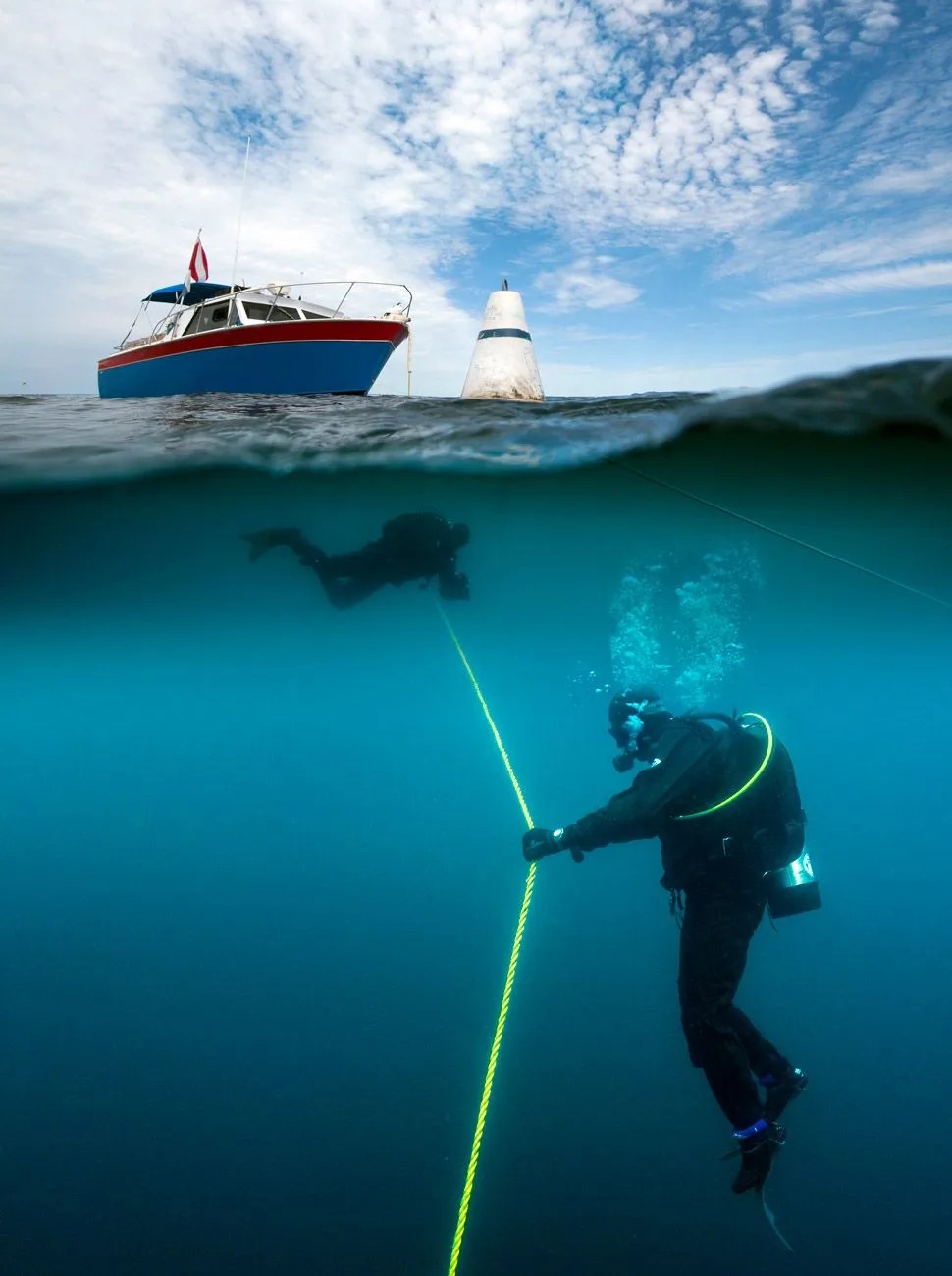
On the 50th anniversary of the Cedarville’s sinking, I found myself descending on her upturned bow, 75 feet below the entrance to Lake Huron. The wreck is immense, the third largest in the Great Lakes behind the Fitzgerald and the Bradley, a full 600 feet long, made more impressive by her final resting position upside down. Pulling down the mooring line, the ship’s great mass pulls magnetically from the depths and her upturned hull comes into view at a mere 35 feet deep. The pilothouse rests only feet off the bottom and I touch down with a puff of silt on the lunar landscape to take in the scene. The ship’s radar mast is dug into the bottom, seemingly supporting the full weight of the wreck, giving me an uneasy feeling as I look up at it. This relatively shallow depth allows ample bottom time to explore a bit, but at the length of two football fields, it’s far too much territory to cover in one dive. After 40 minutes, I head back for the ascent line and a surface interval on the dive boat. We’ll spend all day here, diving the bow again, then amidships where the collision gash is, and finally the stern and engine room within.
The shipwrecks of the Great Lakes cover a vast swath of territory across the border waters between the US and Canada. In the East, the wrecks around Ontario’s Bruce Peninsula in Lake Huron make up Fathom Five Provincial Park, where the wreck of the schooner Sweepstakes, at a mere 20 feet deep, can be seen from the air and can be explored with a snorkel during the warmer months. The waters off of Milwaukee provide excellent diving, highlighted by the car ferry named for the city and the Dutch freighter, the Prins Willem V. Farther north, the Superior waters around Whitefish Point, Michigan are rife with wrecks in a length of shoreline called the Shipwreck Coast. The North Shore of Lake Superior finds the Madeira and the Hesper within reach of shore and at the northern end of Minnesota, charter boats make the three-hour crossing to Isle Royale, where no less than a dozen wrecks litter the surrounding waters.
So if all of this world-class diving exists in the northern US, why don’t more people do it?
So if all of this world-class diving exists in the northern US, why don’t more people do it? For one thing, there aren’t a lot of dive operators taking people out to the sites, many of which lie in remote areas of the lakes. Secondly, the water in any of the Great Lakes is cold. Very cold. With long winters and ice cover that frequently stretches into May, the water has little chance to crack 45 degrees Fahrenheit before the short summer ends and often hovers just above freezing at the depths of the wrecks. This requires the use of a drysuit, which seals out water and insulates with air. The suits are expensive, bulky and restrictive and require special training for their use. And even the best drysuits are no match for icy water and hypothermia is always a lurking danger, making for shorter bottom times. Similarly, the regulators necessary are specially suited for cold water use, resisting freeze-up which could cause a free-flow that can empty an air tank in seconds. Diving in the Great Lakes is simply too uncomfortable, too expensive and too remote for most divers reared on Caribbean reef-combing. But it doesn’t take long for those who can overcome these impediments to discover that the subaquatic adventures found in these waters are among the most rewarding anywhere in the world.
The Chester A. Congdon rests on a steep underwater ledge off the north shore of Isle Royale in Lake Superior. The 532-foot ship sank when she hit an underwater reef, cracking her in half. Her stern end slid down to 200 feet, while the bow remains perched near the apex, aiming up to the surface. Well preserved, her pilothouse is too tempting not to enter and I squeeze my bulky tanks through its narrow door. Stripped clean of its instruments, the space is open and airy, with the distant sunlight filtering down through the upturned windows. I find myself struggling to get my bearings due to the severe angle of the structure as I swim up to the front. I examine the window frames, marveling at their delicate beveled moldings and occasional flecks of paint. The Congdon sank in 1918, yet here’s a wreck more pristine and well preserved than many that have sunk in the past 20 years elsewhere in the world. Only a handful of divers will visit this place, and I feel fortunate to be one of them. For the length of a dive, I am frozen in time.
